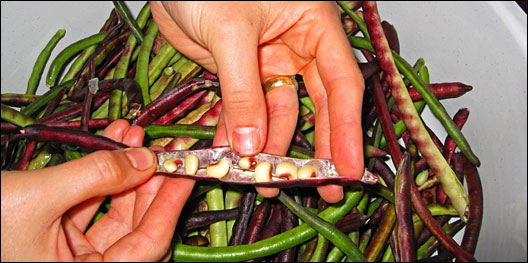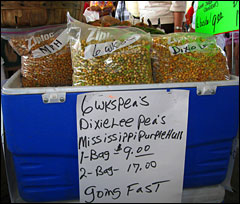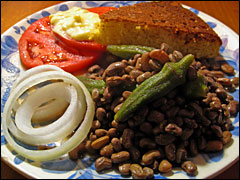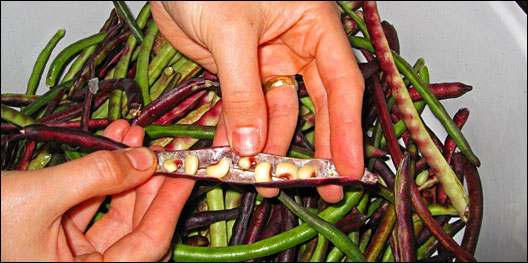
Growing up in a rural Mississippi farming community, I learned to value connectedness to the land, to the people who grow our food, to those who cook it, to those who gather at the table, and to the memories of all who have enjoyed this food before us. My identity is grounded in every step of the process.
To remind myself who I am, I have an annual tryst with a dishpan of purple hull peas. I sit in the rocker on my front porch and shell peas while sipping a glass of minted iced tea. I have made my profession of putting up the summer harvest in the form of pickles, preserves, and chutneys, so prime harvest months of July, August, and September are my busiest of the year.

Peas be with you.
Thus, it has gotten harder and harder to find the time for my pea ritual. Field peas and other shell beans have a long season and stick around until the first frost so I always assure myself I’ll find the time … later. The past few weeks of cool nights caught me by surprise and sent me scrambling to the farmers market in search of my beloved field peas before the first frost ruined my chances. Buying field peas already shelled is a luxury I indulge in once a week all summer long.
I am aware, however, that this convenience is also a sacrifice. For nothing soothes my longing for home like purple-stained thumbs acquired from shelling my family’s favorite purple-hulled pink-eyed peas. I see my grandfather’s hands in mine. I am inspired by that connection, and the peas that I shelled taste better than the peas I buy in the plastic bag. In addition, relenting to the rocker provides a welcomed respite from my daily grind and is more centering than my yoga class.
History in a Hull
What people eat, how they eat, when they eat, and how they procure their food provide rich insights into their culture and their identity. Certain foods in particular capture the spirit of a people. In a region whose obsession with sun-drenched summer vegetables can be observed in our treasured tradition of the four-vegetable plate lunch, no vegetable is more cherished than the field pea. Since the spring green pea is not well suited to the Deep South‘s infamously hot and humid weather, field peas or cowpeas became more popular there, and Southerners began to refer to them simply as “peas.” They then distinguished spring peas by calling them English peas, May peas, or Early June peas.
Black-eyed peas are the most common variety of field peas and are readily available dried or frozen. Sadly, they’re the only field peas that most people have sampled. They do not compare to the farm-fresh varieties. Every region has its favorites, which are the result of localized seed saving, reflecting idiosyncratic preferences in flavor and texture. They come in a wide array of shapes, sizes, and colors with curious names, such as like Red Ripper, Stick Ups, Myrtle’s, Old Timer, and Dixie Lee. Their flavors are remarkably distinct, ranging from “hints of cardamom” to “reminiscent of boiled peanuts.”
Field peas, however, were not always so highly regarded. Brought over with the slave trade because of their adaptability to tropical conditions and high food value, they are known to have spread to Florida from the West Indies around 1700 and to the Carolinas by 1714. The importance of field peas in the diet of the South cannot be overstated. Rivaled in significance only by corn, these sweet little legumes have saved many poor sustenance farmers more times than can be counted.
Nutritious field peas provided the backbone of their diet when the only meat on the table was what seasoned the vegetables. During the Civil War, salt was scarce and those with several hogs had no way to preserve the meat after the slaughter. Without meat, protein-rich field peas became the primary source of nourishment. Many unfortunate Southerners in the path of Union general William Tecumseh Sherman’s incendiary March to the Sea had their livestock slaughtered and their crops and storehouses burned.
Field peas were left untouched, however, because they were considered food solely for livestock and slaves. Aristocratic Southerners, who had previously scorned the humble field pea, now found them the last stave against starvation. Well-earned reverence and exquisite taste, rather than desperation, have driven the consumption of field peas across boundaries of race and class ever since.
Down-Home Cooking
Grown in community soil, shelled on back porches over sweet iced tea and conversation, and later shelled around a community commercial pea sheller, field peas were the center of a network of complex connections to land, family, and community. Even if you did not personally have your own field of peas growing, some family had more than they could use. You would inevitably get the call from a neighbor or family member that the peas were ready for picking.
How I dreaded those dark and sticky mornings when my mother yanked my sister and I out of bed early to pick peas in Uncle Charles’ pea patch before the sweltering August heat caught up with us. Sodden weeds tangled around my toes and slapped my bare legs as I groggily attempted to fill my five-gallon bucket. Despite my abhorrence to picking peas, I always loved to help shell them. Sitting in the floor on sheets of newspaper at my grandparents’ feet, I would rival my sister’s pile of shelled peas, and I felt like a valuable contributor to the nourishment of my family.
Fried chicken, barbecue, and biscuits may be more widely heralded, but a pot of field peas simmered with cured pork and served with crispy, bacon-seasoned cornbread is as iconic Southern as it gets. In summer, we love peas served with fresh sliced tomato and homemade mayonnaise. In winter, a dollop of chutney or relish satiates our penchant for the sweet and sour. This is a tradition that did not adapt well to the market, however, and cafeteria versions fall way short. Fresh field peas, or shell beans as they are sometimes called, are resurging thanks to the recent proliferation of farmers markets.
Be on the lookout for them from mid-summer until first frost.

A “Mess” (Or a Pot Full) of Field Peas with Okra
Growing up, for the entire month of August there was a constant washtub full of field peas or butterbeans in their pods at the foot of my grandfather’s recliner. The whole family would sit around after supper and shell peas while watching television. We would put up dozens of quart freezer bags of field peas each accompanied by several small pods of okra. The okra lent an even greener flavor to the fresh peas and body to the potlikker, and we enjoyed the boiled okra in its own right. We utilized this technique with all field peas. After we’d had a plateful of peas, we broke out the coffee cups and served up sides of their potlikker for dunking cornbread.
4 cups fresh shelled field peas, any variety
2 1/2 cups water (you can substitute chicken stock or pork stock)
One small slice (about 1 1/2 ounces) of salt pork or other cured, smoked or not, piece of fatty pork such as bacon
OR you can substitute 1 tablespoon olive oil plus 1 teaspoon salt
OR a teaspoon of bacon grease
OR you can use a few small pieces of heavily salted fresh pork belly or fatback that you rendered slowly in a pan until well browned
4-5 small whole okra pods
Salt and pepper to taste
Directions
Carefully wash and pick over the peas. Discard any damaged peas and trash. Put the peas in a pot and cover with water or stock. Bring to a boil over med-high heat. At this point the peas will throw off a lot of foam, which needs to be skimmed off. When the foaming stops, reduce the heat to low and simmer for 15 minutes. Then place a handful of small okra pods on top of the peas, cover the pot, and simmer another 10-15 minutes until the peas are sufficiently tender — more than al dente, less than mushy. Taste carefully for seasoning. The amount of salt you will need to add will depend on how salty your seasoning meat or cooking stock is. Serve hot with Black Skillet Cornbread, fresh sliced tomatoes with homemade mayonnaise, and a few slices of sweet onion.
Black Skillet Cornbread
Serves 6 to 8
Cornmeal is very personal. I insist on wholegrain, stone ground white for its nuanced mineral and floral flavors. I regularly wonder whether my current hometown of Carrboro, North Carolina, is the right place for me specifically because I cannot regularly obtain the stuff. I drive 75 miles to Oak Ridge, North Carolina, several times a year to get my cornmeal from the Old Mill of Guilford. I also love the artisan cornmeals produced by Glenn Roberts, the savior of Southern heirloom grains, at Anson Mills in South Carolina. Whole grain cornmeal is perishable and should be stored in the freezer. Many Southerners consider the addition of even a small amount of flour or sweetener in cornbread an abomination. Others insist on it. Cornbread is very forgiving, so play with the proportions until you get the bread that you want.
2 cups cornmeal, preferably stone ground (you may substitute up to half of the cornmeal with all purpose flour if you prefer)
1 teaspoon salt
1/2 teaspoon baking powder
1/2 teaspoon baking soda
4 tablespoons oil or drippings — bacon grease or lard gives distinctive flavor, but a mixture of a high heat vegetable oil, such as safflower or grape seed and butter, makes a fine substitute
1 large egg
1 1/2 cups whole buttermilk or whole milk
A few teaspoons of honey or sugar (optional)
Directions
You really need a 9- to 10-inch cast-iron skillet for this recipe. If you do not have one, I can’t think of any better way to spend $15-20. You can buy cast iron pre-seasoned these days, if that part of the process has always scared you. You may substitute a 9- or 10-inch cake pan or muffin tins, but you will lose some crispness in the crust.
Heat the oven to 450 degrees. Heat the bacon grease or oil in a 9-inch cast-iron skillet in the oven for 10 minutes to get it very hot before you pour in the batter. Whisk the cornmeal, salt, baking soda, and baking powder together in a large bowl. Add the egg and buttermilk and whisk until smooth. Add the sweetener if you wish. With a thick oven mitt or kitchen towel, remove the hot skillet from the oven and very carefully swirl the grease around the pan to coat the sides. Pour about half of the hot oil into the batter and whisk it in. Then pour the batter into the hot skillet. If the batter does not sizzle when it hits the pan, it was not hot enough — heat it longer next time. Place the skillet on the lower oven rack and bake for 15 minutes. Transfer the skillet to the upper rack and continue baking until the cornbread is dark golden brown on top. Remove the skillet from the oven and invert the cornbread onto a large plate or cutting board. Slice into wedges and serve hot. If the cornbread will not be served immediately, it should be cooled on a rack so that the crust maintains its crispiness. The bread reheats in a moderate oven wonderfully.
Homemade Garlic Mayonnaise
Homemade mayonnaise does not deserve its fussy reputation. The rewards are ethereal. Give it a try.
1-2 cloves of garlic, depending on your taste preference
1/2 teaspoon salt
Yolk of one egg*
1 teaspoon Dijon mustard or mustard powder
A few drops of hot sauce or a pinch of cayenne
1 cup of oil (I like a mixture of safflower and olive oil)
2 tablespoons lemon juice
Pound the garlic and salt with a large mortar and pestle, or chop the garlic fine with the salt, and transfer to a medium-sized mixing bowl. Stir in the mustard, egg yolk, and hot sauce or cayenne powder. At this point it is easiest to employ the help of a friend to help pour the oil for you while you whisk. Begin adding the oil drop by drop while whisking vigorously, then increase to a few drops at a time, steadily whisking. When half of the oil has been added, add the rest in a steady thin stream while continuing to whisk. If your arm is tired, switch tasks and let your assistant whisk. Whisk in the lemon juice and taste for seasoning. Add more salt or hot sauce if you like.
* Use caution in consuming raw eggs due to the slight risk of salmonella or other food-borne illness. To reduce this risk, we recommend you use only fresh, clean eggs with intact shells, and avoid contact between the yolks or whites and the outer shell.


